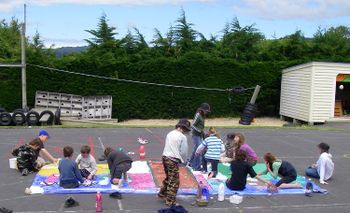Warrington School/The Arts
The Visual Arts
Children learn to:
1. Learn about and use a range of art making media and materials.
2. Experiment with paint, crayon, charcoal, chalk, craft, construction, recycling, 3D, print making, clay etc.
3. Gain knowledge of techniques and understanding of colour, line, balance, light and shade etc.
4. Utilise the skills of local artists and artisans.
5. Express their ideas in creative and imaginative ways and show confidence.
6. Recognise and appreciate the art of various cultures.
7. Critically and constructively evaluate their own and others art works.
8. Look at, discuss and appreciate a wide range of art works.
Music
Children learn to:
1. Enjoy listening to and participation in a range of musical activities.
2. Understand how music is created and sounds mingled to create balance.
3. Recognise, know about and follow some of the elements of music (e.g. melody, harmony, rhythm, beat, pitch, and basic musical notations.
4. Recognise and appreciate different styles of music of other cultures including Maori.
5. Express them selves musically and feel comfortable performing both alone or in a group.
6. Create their own music, recreate the music of others, and develop skills of performing, dancing, listening, singing etc.
7. Learn about famous composers, musicians, singers and their music.
Dance
Children learn to:
1. Enjoy and participate in a range of dance activities.
2. Understand how danced is created from a variety of stimuli.
3. Recognise and know about and follow some of the elements of dance (eg body, space, time, energy and relationships).
4. Recognise and appreciate different styles of dance from other cultures, including Maori.
5. Express themselves through dance and feel comfortable performing both alone or in a group.
6. Create their own dance, recreate the dance of others and develop skills of performing and viewing.
7. Learn about dances and dancers.
8. Learn to use the language of dance.
9. Be an appreciative audience.
Drama
Children learn to:
1. Enjoy and participate in a range of drama activities.
2. Understand how drama is created from a variety of stimuli.
3. Recognise and know about and follow some of the elements of drama (eg role play, time and space, tension, focus, storytelling and mime).
4. Recognise and appreciate different types and styles of drama.
5. Express themselves through drama and feel comfortable performing both alone or in a group.
6. Create their own drama, recreate the drama of others and develop skills of performing and viewing.
7. Learn to use the language of drama.
8. Be an appreciative audience.
